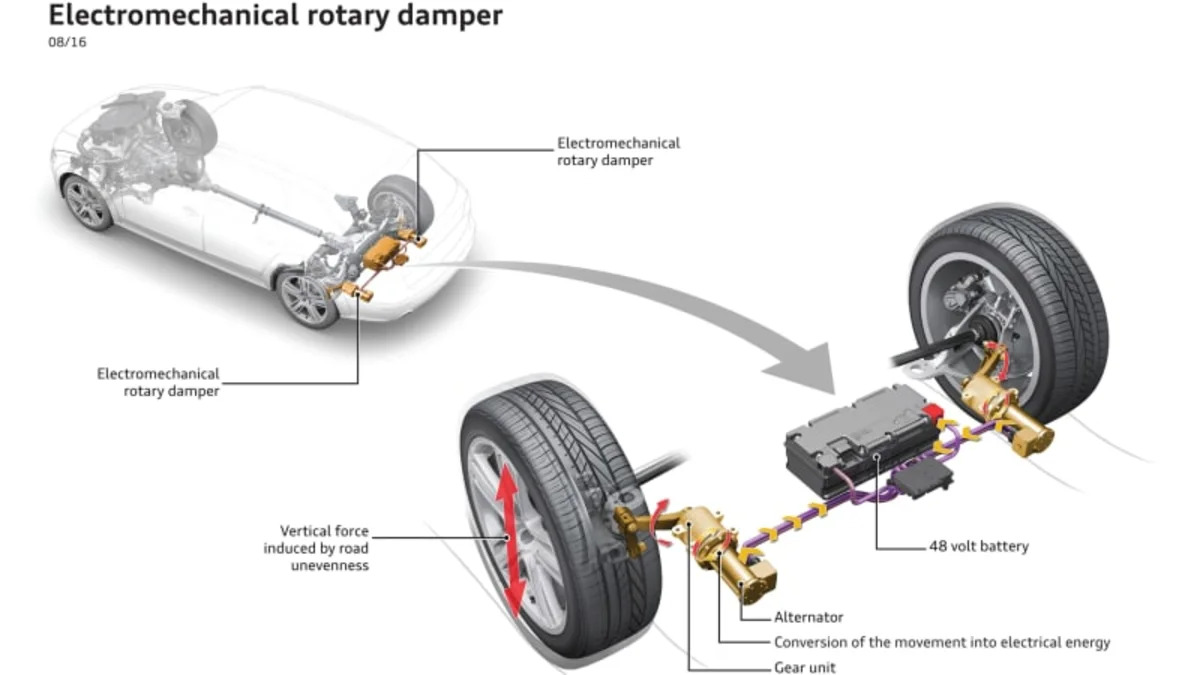Regenerative brakes aren't new. They're on virtually every hybrid and EV, and they're even starting to pop up on traditional gas-powered cars, like with the i-ELOOP-equipped Mazda6. But even with these systems, cars can get more efficient, and Audi thinks it found yet another source of wasted energy. The source? The suspension.
The idea is to turn the kinetic energy that goes into the dampers into usable energy instead of as waste heat. Audi isn't the first auto company to come up with regenerative suspension – nearly three years ago, ZF introduced its GenShock technology, which used a valve attached to traditional, oil-filled hydraulic shocks to recapture kinetic energy from movement caused by bumps in the road. Audi's prototype technology, which it calls eROT, replaces traditional dampers with horizontally oriented electromechanical rotary dampers. eROT is apparently short for electromechanical rotary damper. Neat.
In testing, eROT recovered an average of 100 to 150 watts on a typical German road, three watts from a fresh piece of pavement, and 613 watts on a rough stretch of tarmac (wattage is calculated as power over time, so this is actually the rate at which the system harvests energy). The dampers channel that energy to a tiny, 0.5-kWh, 48-volt battery. The prototype is claimed to cut CO2 emissions by three grams per kilometer (4.8 grams per mile), while the company believes a future production version could save up to 0.7 liters of fuel per 100 kilometers of driving. Converting the savings to American miles per gallon isn't easy, so we'll use a practical example.
In the US, the Q7's supercharged 3.0-liter V6 returns a combined rating of 21 miles per gallon, which works out to 11.2 liters per 100 kilometers. Apply eROT's 0.7L/100km savings, and the Q7's economy would improve to 10.5L/100km, or 22.4 mpg, a 1.4-mpg improvement. That's not huge, but because math, 0.7L/100km is more dramatic on a more fuel efficient vehicle – taking an A3's 27-mpg combined rating and adding eROT would drive efficiency up 2.4 mpg, for example.
There are a few other big benefits beyond fuel and emissions savings – Audi claims eROT provides a more comfortable ride than traditional active suspensions, because engineers can tune the compression and rebound strokes independently of each other. Beyond that, the horizontally oriented rear suspension geometry means more cargo space, since the dampers don't poke up into the cabin like they normally do.
eROT is still firmly in the prototype stage, but Audi claims a production is "certainly plausible" thanks to its promising test results. The company is preparing a new version for 2017, where it will appear on a 48-volt vehicle to "feed a high performance mild hybrid drive." We feel a concept car coming on.
Related Video:

The idea is to turn the kinetic energy that goes into the dampers into usable energy instead of as waste heat. Audi isn't the first auto company to come up with regenerative suspension – nearly three years ago, ZF introduced its GenShock technology, which used a valve attached to traditional, oil-filled hydraulic shocks to recapture kinetic energy from movement caused by bumps in the road. Audi's prototype technology, which it calls eROT, replaces traditional dampers with horizontally oriented electromechanical rotary dampers. eROT is apparently short for electromechanical rotary damper. Neat.
In testing, eROT recovered an average of 100 to 150 watts on a typical German road, three watts from a fresh piece of pavement, and 613 watts on a rough stretch of tarmac (wattage is calculated as power over time, so this is actually the rate at which the system harvests energy). The dampers channel that energy to a tiny, 0.5-kWh, 48-volt battery. The prototype is claimed to cut CO2 emissions by three grams per kilometer (4.8 grams per mile), while the company believes a future production version could save up to 0.7 liters of fuel per 100 kilometers of driving. Converting the savings to American miles per gallon isn't easy, so we'll use a practical example.
In the US, the Q7's supercharged 3.0-liter V6 returns a combined rating of 21 miles per gallon, which works out to 11.2 liters per 100 kilometers. Apply eROT's 0.7L/100km savings, and the Q7's economy would improve to 10.5L/100km, or 22.4 mpg, a 1.4-mpg improvement. That's not huge, but because math, 0.7L/100km is more dramatic on a more fuel efficient vehicle – taking an A3's 27-mpg combined rating and adding eROT would drive efficiency up 2.4 mpg, for example.
There are a few other big benefits beyond fuel and emissions savings – Audi claims eROT provides a more comfortable ride than traditional active suspensions, because engineers can tune the compression and rebound strokes independently of each other. Beyond that, the horizontally oriented rear suspension geometry means more cargo space, since the dampers don't poke up into the cabin like they normally do.
eROT is still firmly in the prototype stage, but Audi claims a production is "certainly plausible" thanks to its promising test results. The company is preparing a new version for 2017, where it will appear on a 48-volt vehicle to "feed a high performance mild hybrid drive." We feel a concept car coming on.
Related Video:



Sign in to post
Please sign in to leave a comment.
Continue